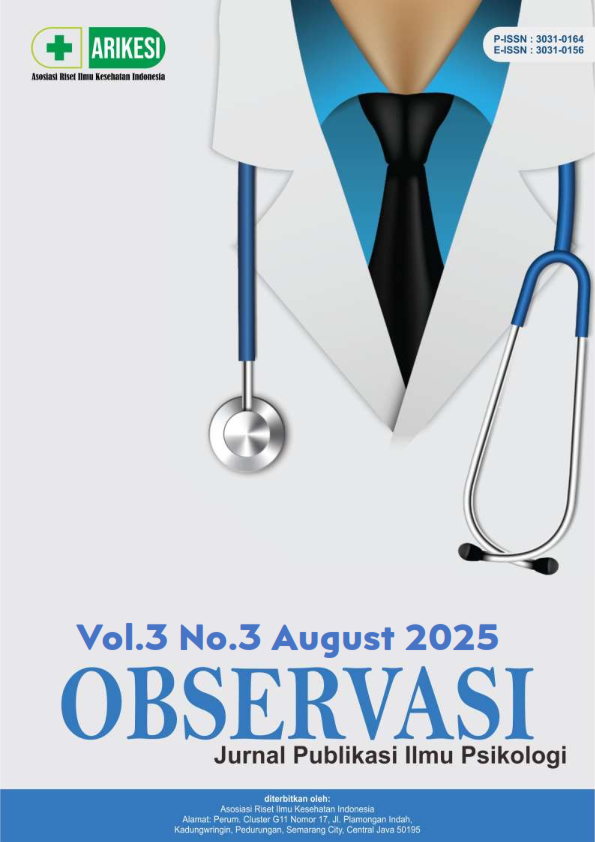Hasil Belajarku Luar Biasa dengan Menggunakan Mind Mapping dan Diiringi Musik Klasik
DOI:
https://doi.org/10.61132/observasi.v3i3.1342Keywords:
Classical Music, Learning Outcomes, Mind MappingAbstract
The purpose of this research is to find out whether the learning method using mind mapping and listening to classical music can improve student learning outcomes. The research design is an experimental design. Specifically using the pretest-posttest Control Group Design. Based on the results of the calculation of the N-gain test, the experimental group's score was 90.44%, where this average category was effective in increasing the learning outcomes of class XI high school students. Based on the results of the calculation of the N-gain test, the control group's score was 57.42%, where this average category was effective enough to improve the learning outcomes of class XI high school students.
Downloads
References
Buzan, T. (2012). The ultimate book of mind map. London: Thornos.
Cahyani, L. I., & Setiyawati, E. (2023). Model of problem based instruction with mind mapping method on learning outcomes of grade 4 elementary school students: Model problem based instruction dengan metode mind mapping terhadap hasil belajar siswa kelas 4 Sekolah Dasar. Indonesian Journal of Education Methods Development, 22, 1–6.
DePorter, B. (2000). Quantum learning. Bandung: Kaifa.
Djohan. (2016). Psikologi musik. Yogyakarta: Galangpress.
Hake, R. R. (1999). Analyzing change/gain scores. [Artikel tidak dipublikasikan, sumber tidak lengkap].
Kurniawan, N. G. (2016). Efektivitas musik klasik (Mozart) untuk menurunkan kejenuhan belajar siswa kelas XI SMAN 4 Yogyakarta. Jurnal Bimbingan dan Konseling, 11, 1–10.
Mapman, M. (2013). Learn with mind maps: How to enhance your memory, take better notes, boost your creativity, and gain an edge in work or school – easily. River Styx Publishing Company.
Mufidah, E. (2023). Pengaruh metode number head together dan mind mapping terhadap hasil belajar siswa mata pelajaran PAI di SMA Taruna Andigha Kota Bogor. Jurnal Dirasoh Islamiyah, 5(1), 172–185.
Obied, R. (2023). The impact of music on brain cells: The case of Mozart’s music. ScienceOpen Preprints. https://doi.org/10.14293/S2199-1006.1.SOR-.PPKUPUA.v1
Panjaitan, D. J. (2020). Musik Mozart sebagai pengiring pembelajaran untuk meningkatkan motivasi dan belajar matematika. Jurnal MathEducation Nusantara, 3(1), 40–48.
Pratiwi, M. I., Safitri, P. T., & Haswati, D. (2022, September). Meningkatkan hasil belajar matematika siswa melalui model pembelajaran mind map diiringi musik klasik. Seminar & Conference Proceedings of UMT, 194–200.
Ramadhona, R. (2016). Penggunaan mind map diiringi musik klasik dalam pembelajaran matematika untuk siswa kelas VIII SMPN 1 Sawahlunto. Jurnal Pendidikan Matematika, 10(2), 1–7.
Rosciano, A. (2015). The effectiveness of mind mapping as an active learning strategy among associate degree nursing students. Teaching and Learning in Nursing, 10(2), 93–99. https://doi.org/10.1016/j.teln.2015.01.003
Seniati, L., Yulianto, A., & Setiadi, B. N. (2005). Psikologi eksperimen. Jakarta: PT Intan Sejati Klaten.
Sulianti, A., Nurwidiani, S., & Siregar, S. S. I. (2020). Metode pembelajaran mind mapping dan musik klasik terhadap hasil belajar sejarah siswa MAN. Jurnal Penelitian Psikologi, 11(1), 16–25.
Susanti, S. (2016). Pengaruh penerapan teori belajar Gagne menggunakan metode eksperimen dalam pembelajaran matematika terhadap hasil belajar siswa kelas IX SMP Negeri 38 Palembang (Doctoral dissertation, UIN Raden Fatah Palembang).
Downloads
Published
How to Cite
Issue
Section
License
Copyright (c) 2025 Observasi : Jurnal Publikasi Ilmu Psikologi

This work is licensed under a Creative Commons Attribution-ShareAlike 4.0 International License.





